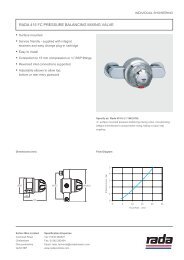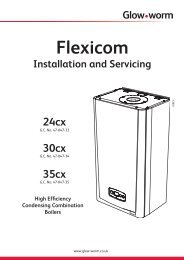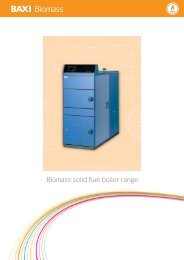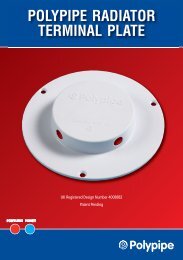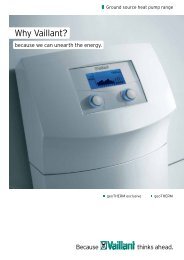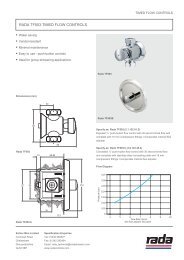Hep20 Technical Handbook
Hep20 Technical Handbook
Hep20 Technical Handbook
You also want an ePaper? Increase the reach of your titles
YUMPU automatically turns print PDFs into web optimized ePapers that Google loves.
Introduction<br />
Underfloor heating provides a<br />
comfortable, highly energy efficient<br />
type of heating. It delivers an<br />
invisible warmth, with no unsightly<br />
heat emitters compromising the<br />
building layout. Allowing maximum<br />
usable area within the building, it is<br />
ideal for both renovation and new<br />
build methods of construction.<br />
This may include the heating of a<br />
conservatory, a one room<br />
extension, domestic or commercial<br />
applications. It is also ideally<br />
suited for the high-ceilinged<br />
spaces encountered in churches<br />
and atriums.<br />
A modern underfloor heating system<br />
consists of continuous plastic pipe<br />
circuits buried in a concrete screed<br />
or run below a timber floor system,<br />
either floating or suspended. The<br />
Hep 2 O ® underfloor heating system<br />
utilises low temperature hot water,<br />
typically 40-55ºC, unlike conventional<br />
heating methods such as radiators or<br />
convectors.<br />
See Figure 13 for a typical domestic<br />
underfloor heating layout.<br />
Material<br />
Hep 2 O ® Underfloor Heating Pipe is<br />
manufactured principally from<br />
polybutylene (PB), a high quality<br />
engineering polymer, designed<br />
specifically for use as a flexible<br />
plumbing material. The highly<br />
flexible nature of polybutylene<br />
means it is the ideal material for an<br />
underfloor heating installation,<br />
allowing the installer to form pipe<br />
circuits with ease, without the need<br />
for preliminary tempering or prewarming<br />
as with other materials.<br />
Hep 2 O ® Underfloor Heating Pipe is<br />
supplied in 16mm and 20mm<br />
diameter Straight Coils, and a variety<br />
of lengths, enabling the installation of<br />
long continuous circuits with minimal<br />
pipe wastage.<br />
Hep 2 O ® Underfloor Heating Pipe is<br />
corrosion resistant and unaffected<br />
by corrosion inhibitors when used<br />
in accordance with manufacturer’s<br />
recommendations.<br />
Benefits<br />
The major benefit of an underfloor<br />
heating system to the end user is<br />
the comfort level provided.<br />
Underfloor heating gives an even<br />
warmth across the entire room<br />
from the floor upwards. Optimum,<br />
individual comfort in these<br />
conditions is achieved when the<br />
feet are a few degrees warmer than<br />
the head.<br />
Hep 2 O ® Underfloor Heating Pipe is<br />
designed for use in underfloor<br />
central heating systems. It is<br />
supplied with an oxygen diffusion<br />
barrier offering maximum<br />
protection against oxygen ingress.<br />
The design of the barrier within the<br />
wall of the pipe offers significant<br />
advantages over underfloor pipes<br />
with an external coating.<br />
Figure 13<br />
Typical domestic underfloor heating layout<br />
Hep 2 O ® underfloor heating manifold<br />
Laying Hep 2 O ® pipe<br />
57



